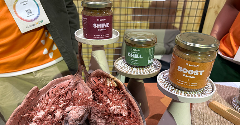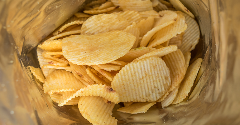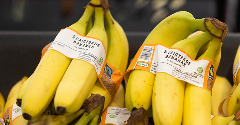News
Children’s food and drink claims centre on health and wellness
1 May 2024A new report by HealthFocus International shows parents are at the forefront of health and wellness trends, leading the way for packaging claims on children’s products.
Parents leading the way is a dominant trend in the food and drink industry, consumer beliefs and behaviour company HealthFocus International states as it publishes its Top 10 Consumer Trends Report.

The trend, Parents Lead the Way, is the idea that parenthood is a tipping point for choosing more control over personal health and wellness. Compared to other consumers, parents are more proactive in learning about health, trying new foods with health benefits, and paying a higher price point for healthy food.
“Parenting has become a catalyst for stronger engagement in the world of health and wellness, and parents are fuelling many of today’s top dietary trends,” Cali Amos, director of Human Insights, shared in the report.
Health and wellness food findings
“For a majority [of people], becoming a parent coincides with enhanced interest in health, nutrition, and safety: caring for others changes their perspectives on food and beverage choices and how health is subsequently affected,” Julie Johnson, President of HealthFocus International told Ingredients Network.
Findings from The Changing World of Health and Wellness for the Family, a 2022 Global Report from HealthFocus International, indicate that 75% of parents are willing to pay more for foods that are healthier for them and their families, compared to 63% of other consumers. Both parents and other consumers interviewed were 40 years of age or younger.
The report suggests that awareness of healthy foods also varied between parents and non-parents. The results show that 73% of parents have gone out of their way to learn about nutrition and its impact on health, and 61% of other consumers share this sentiment.
HealthFocus International’s results also indicate variations in the actions taken by parents and other consumers once they know about a particular product’s health and wellness credentials. Of those asked, 70% of parents confirmed they usually try new foods and drinks that offer health benefits as soon as they are aware of them, compared to 55% of other consumers.
 Data from The Changing World of Health and Wellness for the Family, a 2022 Global Report from HealthFocus International.| Image courtesy of HealthFocus International
Data from The Changing World of Health and Wellness for the Family, a 2022 Global Report from HealthFocus International.| Image courtesy of HealthFocus International
Parents Lead the Way trend
“Parents care about so many things when choosing for their kids,” says Johnson. In nearly every category, households with children at home report more interest, vigilance, and engaged behaviours, HealthFocus International reports.
For instance, when selecting foods and beverages, parents focus more on health benefits such as gut health and immunity, ingredients, and other top health and wellness trends like clean eating, transparency, and sustainability.
Claims on food and drink for children that resonate the most with parents are: ‘fresh’, ‘natural’, ‘no preservatives’, ‘no artificial colours and flavours’ and ‘high fibre’.
“Parents also face a variety of challenges when providing for their family,” says Johnson. According to new data from its HealthFocus 2024 Global Trend Study, parents say the top barriers to improving their children’s nutrition include children asking for products they see or hear about, their children’s preferences, and the expense of healthy foods and beverages.
Changing manufacturers and brands’ formulations
“There’s been a massive shift in how manufacturers try to reach kids and parents,” Johnson says. The shift has been significantly influenced by the past two generations of parents who have access to more information about nutrition and health, shaping their view of what’s healthy and what they feel is okay to bring home.
“Currently, more informed parents have higher criteria for choices for their children, and manufacturers have responded by accentuating – or even changing – ingredient or nutrition attributes,” Johnson adds.
When children ask for the same products, parents who would have dismissed these options in previous formulations see manufacturers highlighting formulations that include whole grain content, less sugar than other leading brands and added fibre, for instance. Manufacturing considerations and packaging claims like these connect parents’ dedication to health and nutrition with their children’s enjoyment.
“We’ve also seen manufacturers actively embrace categories that are not typically exciting to kids in ways parents and children can agree on,” says Johnson, highlighting that yoghurt is a great example. Squeeze pouches, yoghurt tube snacks (which can also be frozen before adding to lunch boxes), and lines specific to toddlers and children with appealing packaging and information about the benefits of probiotics for children resonate with children and parents.
An influx of portable foods, including many combinations of products such as meat and cheese, hummus and crackers, and single-serve items like peanut butter and salad dressing, are product categories satisfying both parents and children. These food options appeal to anyone on the go, but they have particular appeal for those packing lunch boxes daily.
“We will see increasing options in single-serve and portable, with a growing number of healthier-for-you products in these categories,” Johnson says. “Even though they’re almost always at a higher unit price, the convenience of healthier products is enticing to both parents and non-parents alike,” Johnson adds.
Regarding health, nutrition, and food choices for the family, parents today are not the same as parents decades ago. Parents’ knowledge and preferences drive many of today’s top dietary trends.
“So, although children still have a massive influence on their parents’ food and beverage spending, we anticipate seeing more and more manufacturer efforts working to win over parents while making their products interesting and appealing to children and continuing to move into the portable products space,” Johnson adds.
Related news

Balenti adds the benefits of baobab to functional nut butters
19 Apr 2024
French startup Balenti uses sustainably sourced, wild-harvested baobab fruit to make its healthy nut butters with functional benefits.
Read more
Limiting trans fats in Kenyan food products could prevent heart disease
4 Apr 2024
Implementing trans fat restrictions in Kenya could bring about significant health and economic benefits, saving lives and reducing healthcare costs, study finds.
Read more
Cocoa prices likely to increase significantly in 2024
27 Mar 2024
Due to environmental factors, the International Cocoa Organization predicts an 11% drop in global cocoa output, driving cocoa prices up and raising concerns for farmers' livelihoods.
Read more
Ultra-processed food intake in South Africa at concerning levels, study suggests
19 Mar 2024
As South Africa considers introducing front-of-pack warning labels and strict marketing limits for unhealthy foods, research has found that low-income South Africans get around half of their calories from ultra-processed foods (UPFs) – “a cause for con...
Read more
Sainsbury’s reaches living wage goal for banana workers
12 Mar 2024
UK supermarket Sainsbury’s announces it has achieved its industry commitment three years ahead of schedule and encourages other retailers to do the same.
Read more